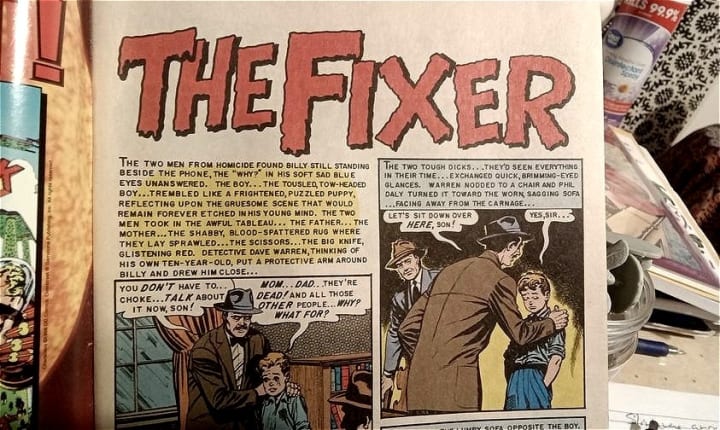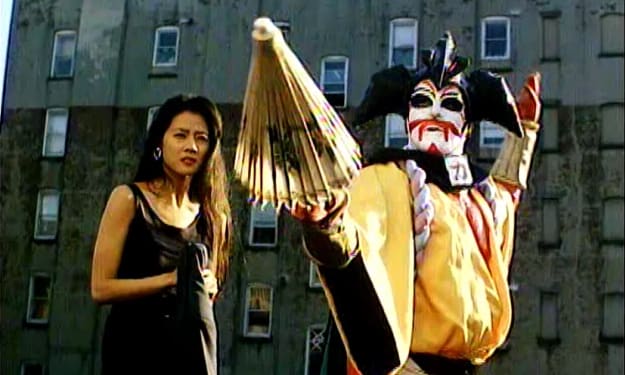
Comic book reviews seem pointless, as you'll most likely never get right out to gobble up the issue I'm writing about (graphic novels, on the other hand, are a pretty popular commodity). Regardless, even though my comic book videos get so few views comparatively, I still feel compelled to write about comics. Mainly because they appeal to me, and they are there. (I mean, in abundance.)
Recently, in a huge haul of fifty random and rare books, I came across an EC reprint of Crime SupenStories Number 26, and another title called "Spicy Tales," both the "under the counter" stuff of yesteryear. (Well, maybe not so much EC, which became an embattled entity during the Senate hearings on juvenile delinquency of the era).
Weird-A$$ Comics 4: Spicy Tales (1930s-40s) "Mature" Comics
Spicy Tales
Spicy Tales Number 3 is Eternity Comics' (another embattled entity it was) reprint from the pulps. Featuring the black-and-white type of art you'd expect from the late Forties era of Golden Age books, the stories are centered around "Sally Sleuth" and "Dan Turner, Hollywood Detective". Sally is featured in a story where she's kidnapped at Pearl Harbor (the story came out, so the Editor claims, a full EIGHT MONTHS before Pearl Harbor) by a Japanese agent who makes her run around bare-chested wearing a conveniently placed lei and hula dancing. Her boyfriend or secret agent male friend or whatever is confined until he creates a snare and a rather dim-witted captor walks into it, and he's strung up like an errant squirrel.
"Okeh," as they might say in 1943 or thereabouts.
Another story has poor Jean being kidnapped and tortured (she gets little bloody spots all over her half-naked nudie cutie self) and then being tied within reach of a jug of water while she bakes out under the hot desert sun. Done by Pancho, who is a bad guy I take it. No racial stereotyping, please; we only have thirty-six or so pages to go.
Yet another tale (and the best ones have cheesecake dames in negligees running around shooting off Mad Gasser of Mattoon briefcases to foil villains with Van Dyke beards who look like Count von Cosel), has native women in cages, kept there so they can be bred with gorillas. I'll leave it at that.
Crime SupenStories (the EC reprint) is par for the course what you'd expect from the geniuses that created Tales from the Crypt, The Vault of Horror, The Haunt of Fear, etc. As the editorial reprinted in the issue makes plain, EC was undergoing attack at the time from self-appointed screech owls of "public morality," who were aghast at the bloody, Grand Guignol offerings in EC titles like Tales. There were Senate hearings, there was public "comic shaming" of wholesalers, newsstands and malt shops got cold feet, and horror and crime titles "most especially" were under attack. Pressure was being put on EC and its imitators to tone down the horror crime and gore.

"The Fixer"
But Crime SuspenStories does not disappoint comic book fans lusting for blood. The first story, a happy-as-Hell little homily called "The Fixer," has some ratty-ass white trash family moving into Lucy Bradshinkel's Bourgeois "Better Homes and Gardens" hoity-toity neighborhood. The Grungeys have a kid whose shirt has a single patch on it (that's the true sign of a raggamuffin), and the father is a drunk. The kid is beat up at school, a rock comes flying through the window, trash cans are overturned...the Whitey Tighty residents of Stepfordville don't want no poor underbelly of society sidling up so close to their well-clipped lawns and white picket fences. Que sera, sera.
Then they start getting 86'd, one by one. Throat slit, mutilated face, you dig it, baby? The dad goes on a drinking binge, the mom weeps and weeps like a comic book mommy should. And the son? Well, he just sort of floats around in the background.
Then, coming home one night drunk, the Father is confronted by the Mother, who accuses him of the neighborhood murders (he's not particularly broken up by any of them). Sparring over a knife she's found, he accidentally stabs her, and she dies on the kitchen floor in a pool of blood. Out of sheer terror and guilt, the Father grabs a pair of scissors and stabs himself in the neck, dying beside his long-suffering little wifey. Gurgle, gurgle, gurgle.
Little Billy or whatever is consoled by the hard-nosed homicide dicks, but then lets the cat out of the bag (as kids are wont to do) to the astounded (choke! choke!) coppers: HE killed the neighbors, killed the ALL. And now, "I killed them all...for nothing!"
Wonk, wonk. All in color for a dime, baby!
We have a tale of a philandering woman who goes to wrestling matches with her paramour, her husband watching at home on the newfangled TV, noting the special seats he has bought them, are now empty. He waits with a gun in hand, shooting wifey and lover as they come through the door. After all, the seats were empty, dig? They must have been off in a honeymoon suite somewhere, making the Beast With Two Backs. Right?
No dice. The wrestling match was NOT, in point of fact, the one his now-murdered wife and her lover had attended. It was a rebroadcast from CHICAGO. CHICAGO! (Slaps forehead.) I ask you: Have you ever? Well, have you!?
We have a story of a pyromaniac fire chief who isn't discovered until the O. Henry ending kicks in with ironic, deadly EC subtlety. His face is an underlit maniac's mask. I like that.
"Living Room Violence"?
There's another story at the back, but I haven't read it yet. The most telling reprint here is the long editorial letter from the old EC editorial staff, asking the readership "who love comics" to write to their representatives or whatever and implore them to take it easy on EC and their imitators. Okeh.
I love this quote:
"A group led by Dr. Freda Kehm, Mental Health Chairman of the Ill. Congress of the P.T.A., decided that living room violence (?) has a 'decided beneficial effect on young minds'."
You really have to hand it to those psychiatrists.
As to whose "young minds" she was referring to, and as to what, exactly, constitutes 'living room violence," the article does not make clear.
The horror and crime and hard pulp comics of the Forties and Fifties ripped the mask off of the American Dream, turning the Eisenhower Era on its head, exposing its ugliness and hypocrisy, the lurking basilisk of social terror swimming just beneath the surface of so many placid and safe suburban lawns. Like Blue Velvet, decades later, it redefined an era, putting the illusion of bourgeois American Exceptionalism to the torch, exposing the "skull beneath the skin," to quote those redoubtable poets of Megadeth.
Everything else is just gravy, baby.
In closing, I should add that one of the "spicy stories" of Spicy Stories saw that handsome young ratiocinator Dan Turner foiling the Japanese plans to dress in zoot suits, which they do to kill a Chinese woman, so her brother in the studio outside of which she is murdered eventually guns down the perps. In cold-blooded, "mass casualty shooting incident" style. 'Twas the era of "family values," for sure.
(And he gets a pat on the back, man.)
Family values.
About the Creator
Tom Baker
Author of Haunted Indianapolis, Indiana Ghost Folklore, Midwest Maniacs, Midwest UFOs and Beyond, Scary Urban Legends, 50 Famous Fables and Folk Tales, and Notorious Crimes of the Upper Midwest.: http://tombakerbooks.weebly.com






Comments (1)
As they've pretty much always been, if I do say so myself. Enjoyed the article & video thoroughly, Tom.